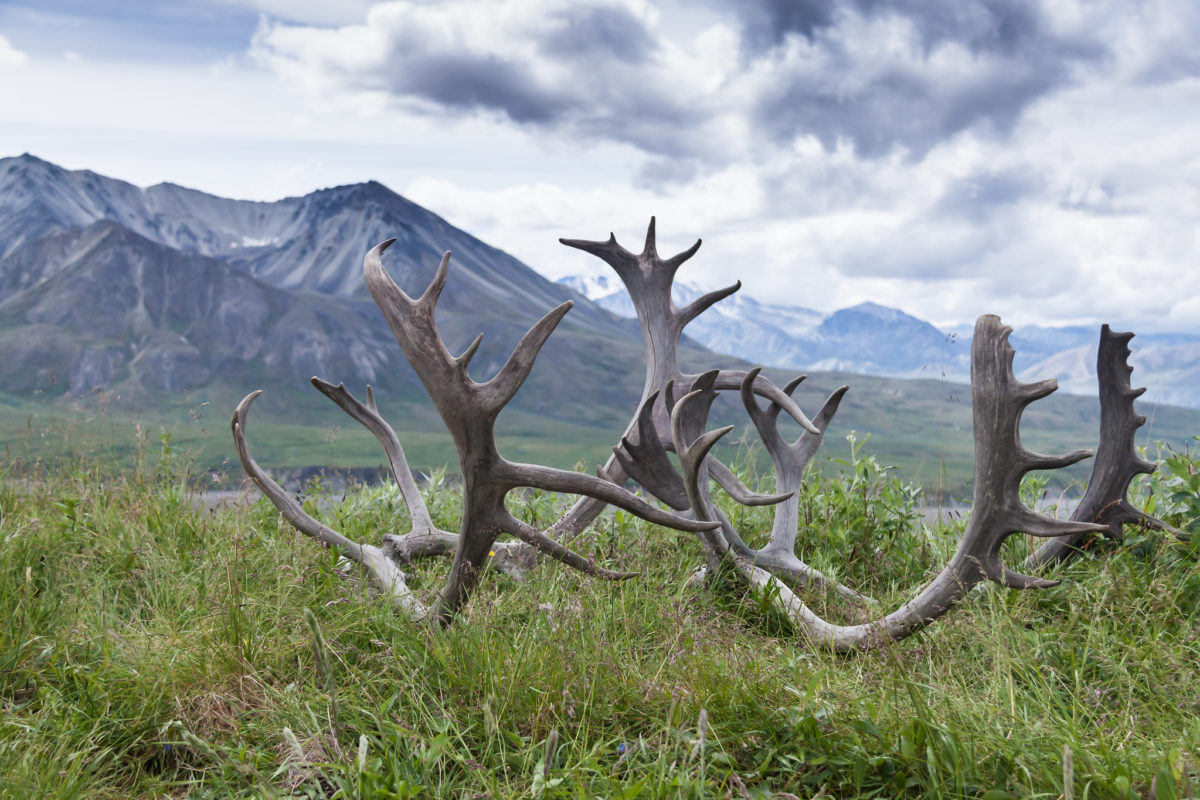Introduction
The near-time fossil record includes the last 2.6 million years, spanning the Pleistocene and Holocene epochs, which together make up the Quaternary Period. Many of the species that lived during this time are extant, making it possible to directly compare organisms and their interactions from the past with those of today. These comparisons form the basis of the approaches used by conservation paleobiologists studying the youngest record. More specifically, conservation paleobiology studies of the near-time geohistorical record work to: (1) establish biological baselines to informed restoration targets; (2) evaluate biological responses to human actions and natural processes, and differentiate between the effects of the two; (3) quantify the natural variability in ecosystems; (4) identify ecological legacies that are unexplainable based on present biodiversity. As we will see in the examples that follow, these objectives are not mutually exclusive and data from the geohistorical record can often be applied towards several objectives at the same time.
Using historical variability to improve decision making
In the Arctic National Wildlife Refuge (Alaska, USA), pressure to expand petroleum production is at odds with conservation of the Porcupine Caribou Herd. Proposed areas for petroleum exploration and development overlap with the habitats used by the caribou for calving (i.e., giving birth). With or without expansion of the petroleum industry, efforts to manage the caribou herd are limited by a lack of data on historical land use by the herd. As the climate warms and habitats change, particularly in these northern latitudes, the herd will likely modify its behaviors, including the areas used for calving. Aerial surveys from the last several decades have shown considerable variation in caribou land use for calving on annual and decadal scales. The highly variable behavior of the caribou suggests the need for a longer perspective to fully understand their pattern of behavior. This perspective is available from the geohistorical record and can be used to evaluate the consequences of petroleum development, project future land use patterns as the climate warms, and ensure a sufficiently large and diverse habitat is maintained for caribou calving grounds.
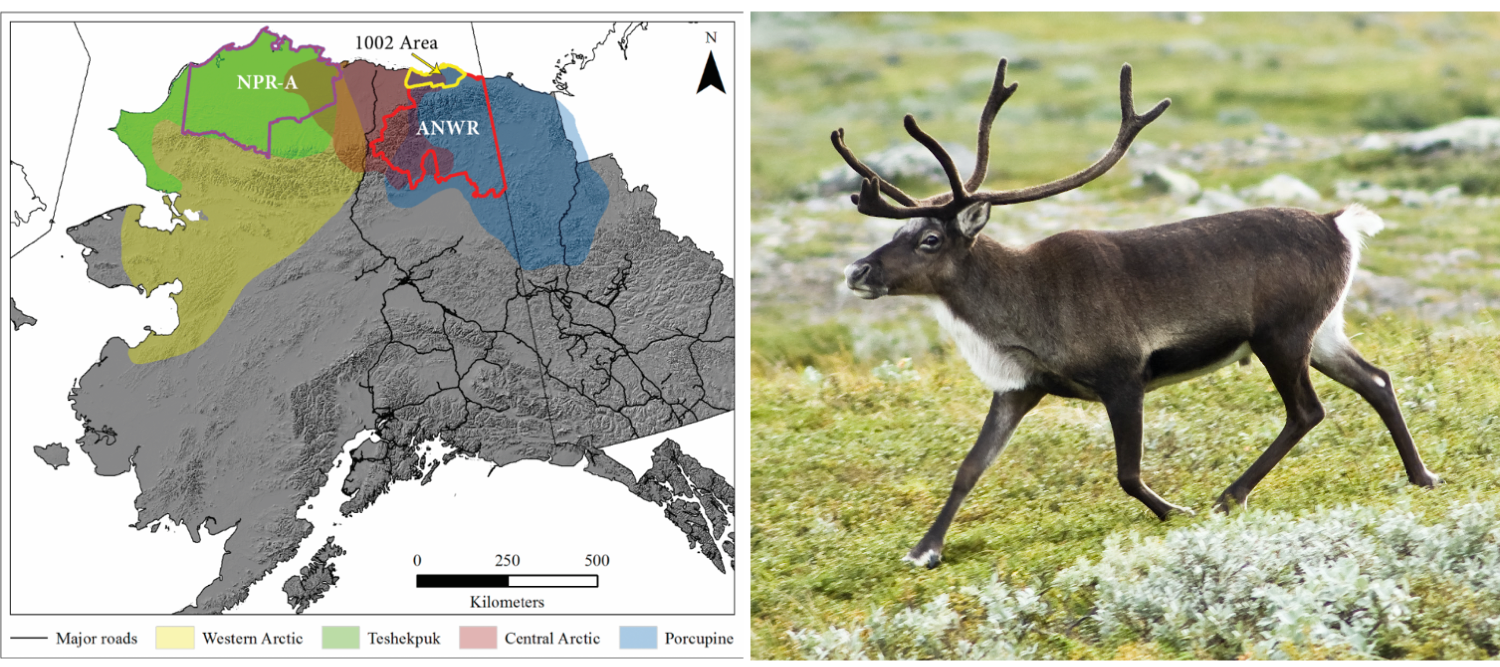
"Map of approximate annual distributions of northern caribou herds in Alaska and Canada and approximate boundaries of the National Petroleum Reserve (NPR-A) and 1002 Area, Arctic National Wildlife Refuge (ANWR), Alaska." The 1002 area, which falls within the ANWR, is under consideration for petroleum development. The right image shows a caribou on the tundra in summer. Left image from Pearce et al. (2018) from the USGS (public domain). Right image by Alexandre Buisse; GNU Free Documentation License.
A team of researchers, led by Josh Miller, collected caribou antlers and skeletal remains in northern Alaska to evaluate the long-term pattern of land use by the herd. Caribou are unique from other deer-like species (i.e., cervids) in that both males and females grow antlers. Conveniently, females retain their antlers until after calving their young, at which point they shed the antlers. The female antlers—which can be distinguished from male antlers based on the size of the surface where the antlers attach to the skull—and skeletal remains of juveniles that died shortly after birth can be used to estimate where and how often the caribou use areas for calving. Based on these accumulations, Miller et al. (2013) found that the caribou made extensive use of the Dryas terrace and dwarf shrub habitats shortly after calving, identifying these as historically important areas to maintain for the caribou. The remains also commonly occurred along openly vegetated riparian terraces, suggesting a need to maintain these areas as well.
These near-time geohistorical records provide a unique perspective on the historical range of habitat use in the Arctic National Wildlife Refuge and can be used to prioritize the conservation of high-importance habitats, now and as the climate warms. This tool can also be applied to other arctic regions where caribou occur in Canada, Russia, and Scandinavia.
Understanding biotic responses to habitat change
The Colorado River estuary, which sits atop the northern Gulf of California (Mexico), supports hundreds of migratory species, is home to a great many endemic species, and contributes to a productive fishery. Habitat change in the estuary threatens all of these species and the livelihoods of the people living and working in the region. Whereas it is clear the estuary has changed, and continues to, the extent to which it has changed remains challenging to define. There were no ecological studies in the estuary predating the habitat change.
Learn more about water use and its consequences in this video on the "Colorado River" by PPICvideos. Source: YouTube.
Habitat change in the estuary is largely driven by a reduction of freshwater flow from the Colorado River. Since the river was dammed and its waters were diverted, starting in the 1930s—only a trickle of freshwater has reached the estuary in most years, and in many years no freshwater flows into the estuary. In an ecosystem that historically received more than 15-million acre feet of water each year—enough water to satiate the entire USA population for 200 days, or enough water to fill 7.5 million Olympic swimming pools—this reduction in freshwater input is likely to have resulted in substantial change to the habitat.
In the absence of ecological studies prior to the 1930s, geohistorical records can provide invaluable context for understanding how the Colorado River estuary has changed. This is doubly true due to the large accumulations of seashells from the last several thousand years that can be found in the estuary. These accumulations, called cheniers, contain trillions of clam and snail shells, providing a sense of what the molluscan community looked like prior to upstream dams and water diversions. The reduction of the Mulinia modesta population in the estuary is one of the most striking examples of change. Of the trillions of seashells in the cheniers, 85–95% of the shells are Mulinia. Whereas Kowalewski et al. (2000) estimated living densities of 50 Mulinia in every square meter of the estuary during the past, surveys of the community living in the estuary today show only 3 individuals per square meter. The population has declined by as much as 94% since the Colorado River stopped flowing into the estuary on a regular basis.
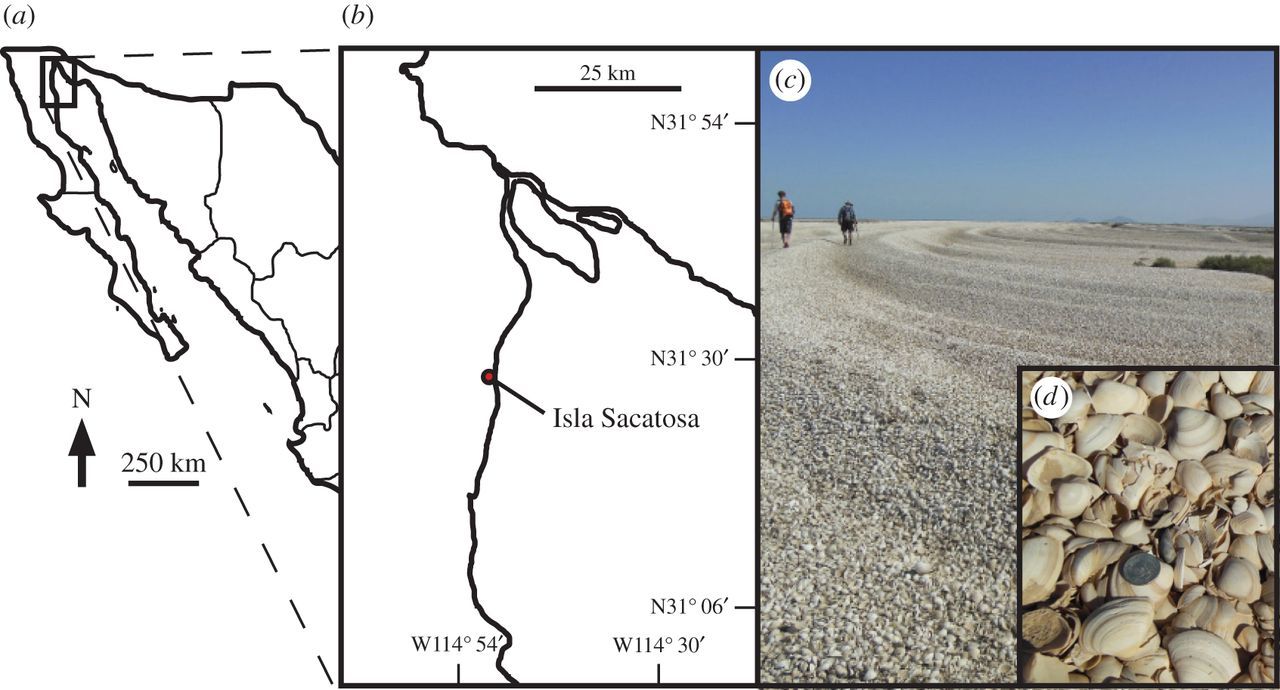
"Cheniers in the Colorado River delta. (a) Location of delta in Mexico. (b) Colorado River delta locality from Kowalewski et al. (2000). (c) A chenier in the Colorado River delta at a locality south of Isla Sacatosa. (d) Close-up of Mulinia coloradoensis; coin, 0.24 cm in diameter." Image and caption from Smith et al. (2016) in Royal Society Open Science; Creative Commons Attribution 4.0 International license.
Comparisons of the seashells in the cheniers with the clams and snails still living in the estuary suggest additional changes beyond the decline of the Mulinia population. Most notably, the community is shifting from one tolerant of brackish water—a mixture of salty seawater and freshwater—to a more fully marine community. For example, the predatory snail Notocochlis chemnitzii was not found in the estuary in the past but now occurs there regularly, likely because it is no longer excluded by the brackish conditions. Likewise, numerous species that favor higher, marine salinities are encroaching northward. The estuarine community is being replaced by a marine community.
As freshwater flow is needed to recreate the natural, brackish conditions, it is possible that allowing freshwater flow to resume may restore the estuarine community, though it is generally accepted that the flow volumes will never match the historical Colorado River flows due to human use. Even so, smaller flow volumes, such as those released in 2014 for restoration (learn more in the video below), may be suitable to restore smaller areas of the estuary towards historical conditions. Without the geohistorical record, it would not be possible to define what is historical in the estuary. By using the geohistorical records, restoration efforts can be directed towards appropriate targets. Basing restoration targets on the current living community could be misleading, as the current community is not what was present historically. Indeed, populations of the marine species (e.g., Notocochlis) that are now found in the estuary will likely decline as the remnant populations of the estuarine species (e.g., Mulinia) expand. Geohistorical records provide a means to set restoration targets and evaluate the success of restoration efforts.
Learn more about the restoration efforts in this video on "Bringing Back the Colorado River Delta - 2013" by The New York Times. Source: YouTube.
Ecological legacies: Anachronistic seeds and fruits
Coevolution—the influence of closely associated species on each other in their evolution—between plants and animals has resulted in numerous novel species, some with seemingly peculiar specializations. Since the evolution of angiosperms during the Cretaceous (learn more about Angiosperms), their characteristic fruits and flowers have played prominent roles in these types of relationships. Angiosperms use their fruits and flowers to bribe animals with a tasty meal (e.g., nectar, fruit) and, in turn, the animals aid in plant reproduction through processes like pollination and seed dispersal (learn more on Angiosperm dispersal). After thousands, if not millions, of years, the relationship between plant and animal can become so tightknit that their morphologies even appear to be compatible. For example, the beak of the hummingbird in the image below appears to be almost perfectly suited to harvest nectar from the flowers it is visiting. The evolutionary fate of these coevolved species is often closely connected; however, in some cases, species will persist without their specialized counterparts as ecological legacies.
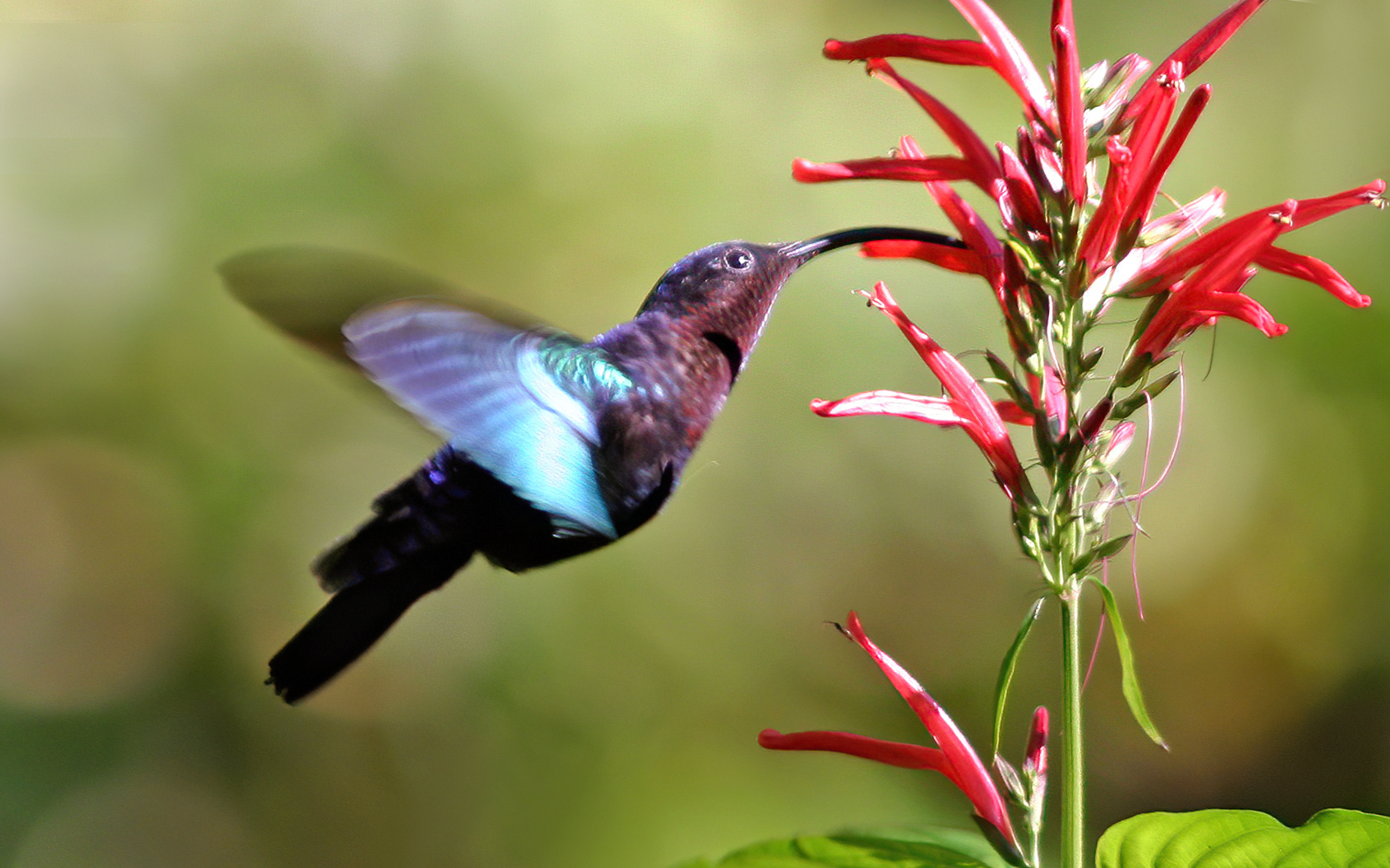
A purple-throated carib hummingbird feeding on flowers seemingly shaped to fit its beak. Image by Charles J Sharp; Creative Commons Attribution 3.0 Unported license.
Ecological legacies can be challenging to interpret, as biologists are only presented with what is essentially half of a puzzle. Using that half of the puzzle (i.e., the surviving species), biologists try to understand the type of organisms it evolved with, and the functional relationship between the species. The geohistorical record can help with these interpretations and provide us with otherwise unavailable context for the distribution of biodiversity in the world today. For example, the fossil record of Cenozoic megafauna can help explain the abundance and distribution of fruiting plants with large seeds in various places around the world. The excessively large seeds in many of these plants (see image below), are too large to be consumed by any animals alive today. But, given that Guimarães et al. (2008) found more than one hundred different types of plants—from unrelated families, such as Fabaceae (this family includes beans, peas, and legumes), Solanaceae (this family includes eggplant, potatoes, and tomatoes), Malvaceae (this family includes okra, cotton, coffee), and Arecaceae (this family includes the palm trees), among others—with these large seeds, it would seem there must have been species capable of consuming them.
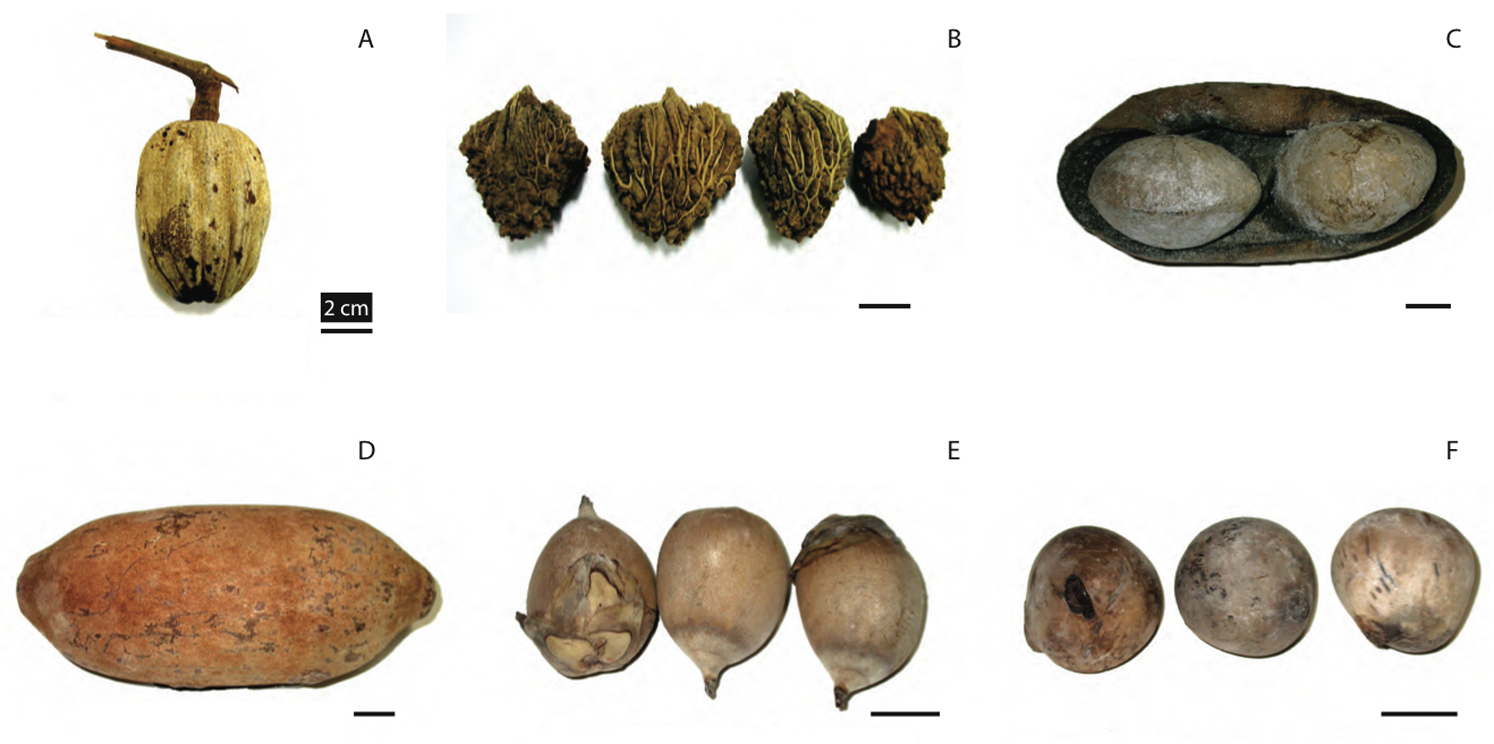
"Examples of megafauna fruits and seeds. a, Lacunaria jemmani, Quiinaceae. b, Parinari montana, Chrysobalanaceae (seeds); c, Caryocar villosum, Caryocaraceae, fruit split open with two seeds; d, Theobroma grandiflora, Malvaceae; e, Attalea martiana, Arecaceae; f, Phytelephas macrocarpa, Arecaceae (seeds). Black line is 2 cm length. Photos from specimens at Herbarium João Murça Pires (MG) of the Museu Paraense Emílio Goeldi, Belém, Brazil; by PJ." Figure and caption from Guimarães et al. (2008) in PLoS ONE.
As shown in the fossil record, there were once numerous large mammals that were capable of ingesting and dispersing these fruits and their seeds. Unfortunately, many of these mammals—including proboscids (relatives of elephants), mylodontids (giant ground sloths), and rhinocerotids (relatives of rhinoceros)—are now extinct. Nonetheless, the fossil record of these groups can explain why there are so many living plants with large seeds but no living species capable of ingesting them. By understanding the ecological legacies presented by these anachronistic plants, we can more effectively conserve them, if we choose to, by maintaining the functions (e.g., seed dispersal) once contributed by the other half of their legacy.
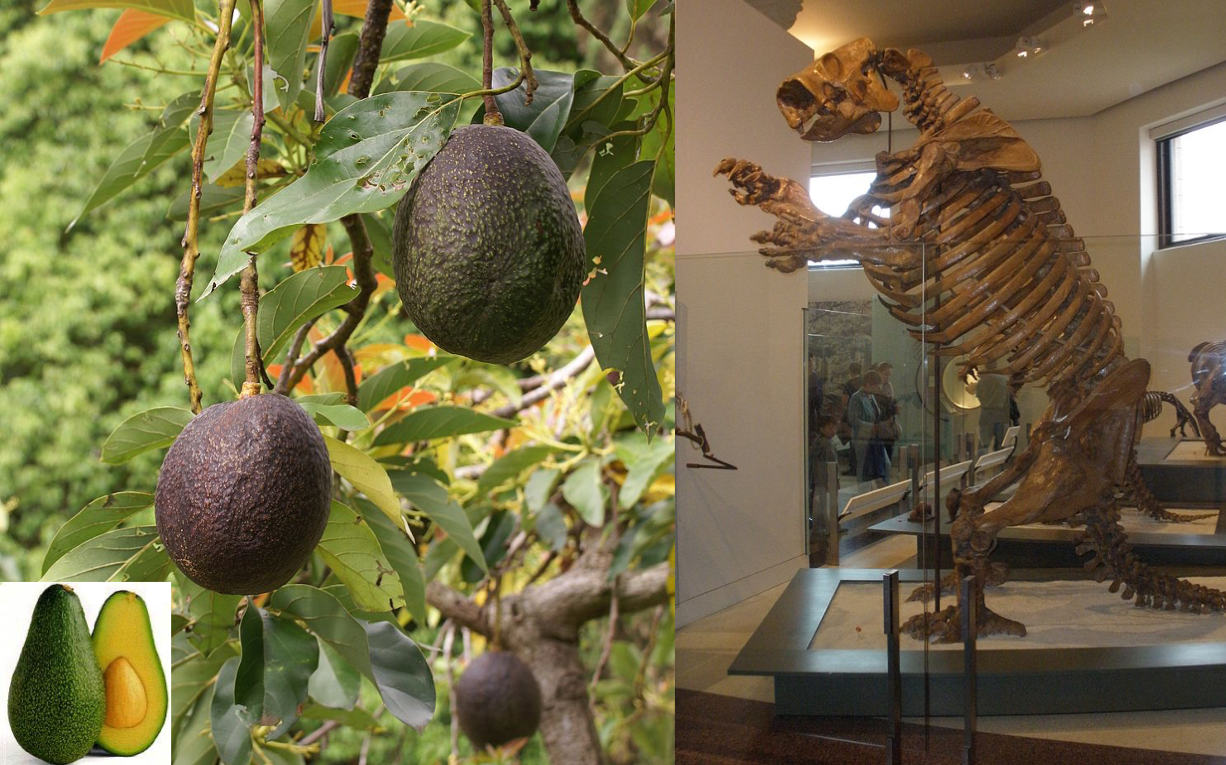
Avocados were consumed by giant ground sloths, such as Lestodon (right), which then dispersed the large seeds. Left image by B.navez; GNU Free Documentation License. Lower left image is in the public domain. Right image by Ghedoghedo (public domain).
The avocado, now a mainstay in many human diets, is one such ecological legacy. If you have ever cut into an avocado, you have encountered the large, golf ball sized seed at its center. These seeds, which are toxic to many modern mammals when raw, would have been swallowed whole by the fruit’s early consumers: giant ground sloths (e.g., Lestodon). These giant sloths, which reached lengths of fifteen feet—and other megafauna like gomphotheres and glyptodons (giant armadillos)—feasted on avocados and spread their seeds throughout Central and South America. As humans spread across the Americas, nearly all of the megafauna went extinct around 13,000 years ago, threatening the demise of the avocado with the loss of its primary dispersers. Fortunately, the plant persisted long enough for people to begin eating its flesh and cultivating it into the fatty, fleshy fruit we know today. Next time you enjoy an avocado, think fondly of the giant ground sloth!
Learn more about "Why Avocados Shouldn't Exist" in this video by SciShow. Source: YouTube.
Concept check: See what you know!
The near-time geohistorical record extends from today to ___________.
2.6 million years ago
True or False: Species in the near-time record tend to be extinct and are not comparable to those living today.
False! One of the strengths of the near-time record is that the species are largely still living today, enabling comparisons between past and present communities.
Caribou are somewhat unique compared to other cervids (i.e., deer-like animals) in that both males and females grow antlers. How is this useful in conservation paleobiology?
Because female caribou grow antlers and shed them shortly after calving, conservation paleobiologists can examine the distribution of female antlers across a landscape to determine what habitats are used during calving. This information can be used to improve conservation decisions, like where to establish a reserve.
In the Colorado River estuary, how might accumulations of snail and clam shells be used to inform conservation and restoration?
The accumulations of shells represent the community from the past, prior to the human actions that resulted in habitat change. This community can be used to establish restoration goals that reflect historical fidelity.
In your own words, what describe what is meant by the term ecological legacy.
An ecological legacy is a memory, or carryover effect, in a modern ecosystem from events or interactions in the past.
References and Further Reading
Barlow, C. 2002. The ghosts of evolution. Perseus Books Group, New York. 304 p.
Cintra-Buenrostro, C. E., K. W. Flessa, and A. S. Guillermo. 2005. Who cares about a vanishing clam? Trophic importance of Mulinia coloradoensis inferred from predatory damage. Palaios, 20: 296-302.
Dietl, G. P., and J. A. Smith. 2017. Live-dead analysis reveals long-term response of the estuarine bivalve community to water diversions along the Colorado River. Ecological Engineering, 106: 749-756.
Guimarães, P. R. Jr, M. Galetti, and P. Jordano. 2008. Seed dispersal anachronisms: Rethinking the fruits extinct megafauna ate. PLoS ONE 3: e1745.Galindo-Tovar, M. E., N. Ogata-Aguilar, and A. M. Arzate-Fernández. 2008. Some aspects of avocado (Persea americana Mill.) diversity and domestication in Mesoamerica. Genetic Resources and Crop Evolution, 55: 441-450.
Kowalewski, M., G. E. A. Serrano, K. W. Flessa, and G. A. Goodfriend. 2000. Dead delta's former productivity: two trillion shells at the mouth of the Colorado River. Geology, 28: 1059-1062.
Miller, J. H., P. Druckenmiller, and V. Bahn. 2013. Antlers on the Arctic Refuge: capturing multi-generational patterns of calving ground use from bones on the landscape. Proceedings of the Royal Society B: Biological Sciences, 280: 20130275.
Pearce, J.M., P. L. Flint, T. C. Atwood, D. C. Douglas, L. G. Adams, H. E. Johnson, S. M. Arthur, and C. J. Latty. 2018. Summary of wildlife-related research on the coastal plain of the Arctic National Wildlife Refuge, Alaska, 2002–17: U.S. Geological Survey Open-File Report 2018–1003, 27 p.
Smith, J. A., and G. P. Dietl. 2019. Molluscan metacommunity dynamics in the Colorado River estuary, Mexico before upstream water diversion. Anthropocene, 25: 100194.
Usage
Unless otherwise indicated, the written and visual content on this page is licensed under a Creative Commons Attribution-NonCommercial-Share Alike 4.0 International License. This page was written by Jansen A. Smith. See captions of individual images for attributions. See original source material for licenses associated with video and/or 3D model content.



